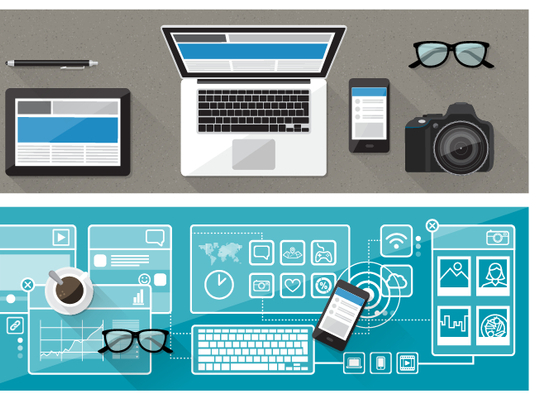
“Is that an iPhone 11S or are you just happy to see me?,” #GNTECH asks OB-15. “Delivery from: X-Future PR for #GNTECH,” replies the ground-based semi-autonomous cargo delivery drone. After scanning a palm for identity verification, it trundles off to the men’s lifestyle guys, alpha., who are expecting a coiffured top hat for a review of their own. After that, OB-15 will roll back downstairs to await a fresh drop-off from one of its thousands of airborne cousins zipping across the city’s sky.
Meanwhile, one of our more flamboyant editors at GN Focus is busy trying so understand blueprints for a 3D-printed carrot velouté to be used in a fine French dining shoot. Another editor is wandering through the Amazon rainforest via an IMAX 4D VR headset, with smells and everything, in order to write a travel feature. At my standing desk, a message informs me of the events I think will make a great story for the 125th #GNTECH issue.
It’s the year 2025 and things at work aren’t what they used to be. “Artificial intelligence, machine learning, robotics and 3D printing will be the next trend in the office space,” explains Santosh Varghese, General Manager for Digital Products and Services at Toshiba Gulf.
“AI will be the game changer; it will drive machine learning, office staff productivity and control will be managed by smart systems instead of human bosses.” With machine learning, smart devices will be able to understand concepts and ideas with greater nuance — not only finding something on demand with greater accuracy but also delivering results in the time and situation for which they are most useful.
What excites Varghese most is managerial changes. He expects a “boss-free” world in the office. “The workforce will be highly collaborative with smart machines and even robots, which will be [in the form of] creative office boys that provide data sources and analysis.” Let’s hope ROBOSS is as sympathetic as its human predecessor at your next performance review…
Printing is another area experts expect to change drastically in the next decade. “A crucial service within the automation sector today would be Managed Print Services [MPS],” says Andrew Horne, General Manager, Xerox Emirates. He uses the word printing not in the traditional sense — clicking print in Microsoft Word — but as an all-encompassing term that covers everything from hardware to IT support (think of all the times you’ve had to call them to ask why your report won’t print) and even ink and toner supplies.
It’s about optimising workspaces and evolving with changing work styles, integrating into business workflows and document management systems, and ultimately to managed document or content services where all information is channelled through a one-stop shop service that handles information framework creation to hosting, management, security, analytics and business support. At least that’s what Horne says. His company offers a present-day solution for this – the Xerox Next Generation MPS — but it’s interesting to wonder how it will look in ten years.
#GNTECH glimpsed another possible future of printing at the Canon Expo in Paris two months ago, where the imagePRESS C10000VP, a colour digital print engine, spat out 100 pages in a minute with crisp tones. This is a far cry from our situation at the office right now, where we have to deal with a machine our boss nicknamed Bob Marley — because it’s always Jammin’.
What other office gear can we expect big change from in 2025? Varghese believes that PCs won’t be around in 2025. At least not how we know them now. And neither will keyboards and even the mouse. “PCs will be tiny nail-sized internet of things [IoT] devices, which will help in computing and machine learning [and] apps, with smart robots filling the office space.” He adds that input devices such as keyboards and touchpad-ready styluses will be rendered redundant thanks to smarter voice recognition – white-collar workers can expect a potentially chattier workplace in a decade.
Perhaps one of the biggest challenges that comes with cutting-edge workplace automation technologies is cost. This obviously impacts small and medium-sized enterprises (SMEs) harder than your average blue chip. Horne says the answer lies in change management, for which he says Xerox offers a professional programme.
All in all, the office could be a lot more interesting in future. #GNTECH needs to do some actual work now; ROBOSS might not be around yet — but our human boss is watching.












